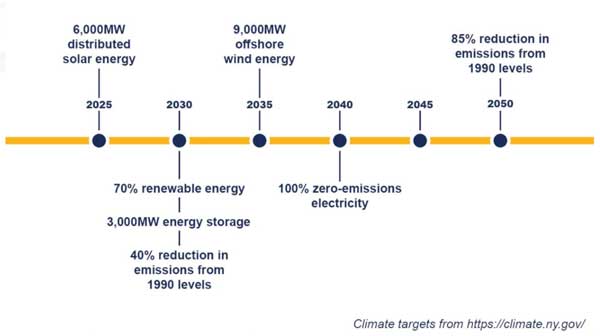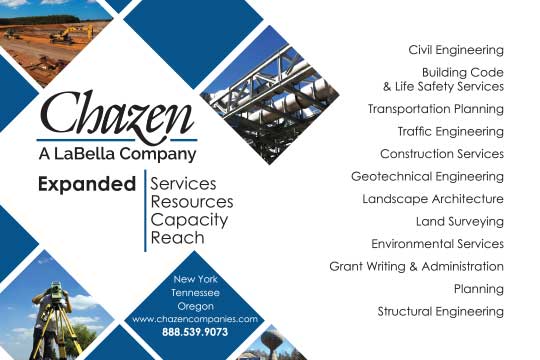By Michael B. Mager
Couch, White, LLP
UNDERSTANDING THE POTENTIAL IMPACT OF THE CLCPA ON NEW YORK BUSINESSES
![]()

On July 18, 2019, Governor Cuomo signed into law the Climate Leadership and Community Protection Act, or CLCPA, the nation’s most aggressive climate law. Among other goals, the CLCPA requires statewide greenhouse gas emissions to decrease by 60% of 1990 levels by 2030 and 85% by 2050. With respect to power, the CLCPA requires that renewable resources provide 70% of the State’s electric needs by 2030 and that the electric system be zero-emission (no carbon-producing generation) by 2040. These goals are very aggressive and will require a massive investment of dollars to achieve. Every business in New York State should be aware of this law and its ramifications.
The CLCPA created the Climate Action Council, or CAC, whose task is to decide the implementation details. The CAC is a 22-member committee comprised primarily of State agency heads or their designees. The CAC is supported by two working groups, seven advisory panels, and other outside groups. Currently, the working groups and advisory panels are meeting regularly to formulate recommendations that will be advanced to the CAC by March 31, 2021. The CAC will take the recommendations and analyze them to select the ones that satisfy the goals of the CLCPA. Ultimately, the CAC must submit a Draft Scoping Plan to the Governor by January 1, 2022, that meets the requirements of the CLCPA.
Responsibility for reducing emissions from the electric generation sector falls squarely on the New York State Public Service Commission, or PSC, the agency responsible for regulating the gas and electricity sectors. By June 30, 2021, the PSC will establish a program that ultimately must result in all electric generation to be “zero-emission” by 2040. By July 1, 2024, the PSC also must establish a program to procure approximately 18,000 MW of renewable generation resources by 2030. These procurement programs are expected to cost New Yorkers billions of dollars in incentives and long-term contracts that exceed market prices.

The CLCPA will result in significant other costs as well, as the Legislature has passed other laws to complement the CLCPA. One such law mandates new electric distribution and transmission upgrades to move renewable energy from upstate regions to load centers downstate. Furthermore, the Commission has a broad portfolio of policy proceedings, many predating the CLCPA, that have been expanded to achieve CLCPA goals. Examples include the Clean Energy Standard, whereby that State’s electric utilities and other commodity providers are required to subsidize renewable energy projects and nuclear generation plants, the costs of which are recovered from consumers. There is a complementary proceeding to procure significant amounts of offshore wind – with the costs again borne by utility customers. Substantially increased investments in energy efficiency and electric vehicle infrastructure also will be recovered from New York consumers.
There is no denying that the costs of addressing climate change and enacting the CLCPA, either directly or indirectly, will be enormous. Renewable energy development is expensive, and New York energy consumers have already contributed billions to its development in the form of subsidies and increased transmission investment. Moreover, the cost of these initiatives frequently are recovered on a per-kilowatt-hour basis, thereby placing an extra burden on larger consumers such as businesses.
In addition, there are major plans to electrify the transportation and building sectors, which account for approximately 66 percent of GHG emissions in the State. Transmission and distribution infrastructure to support the movement of renewable energy to customer load centers, and the electrification of the transportation and building sectors, will cost many tens of billions of dollars more. For example, the CAC has discussed aggressive targets for purchasing electric vehicles, and possible approaches that would provide additional incentives for purchasing them, and/or instituting penalties and/or taxes for not purchasing them. The CAC also has discussed targeted regulations to phase out fossil fuel-based heating and cooling in buildings, as well as increased spending for energy efficiency.

While efforts to reduce GHG emissions should be pursued, each program and policy that the CAC adopts will come at a cost, and, depending on how the CLCPA is implemented, the cumulative price tag might very well be prohibitive for New York businesses. In response to several requests for a comprehensive study of the cost of CLCPA compliance by Multiple Intervenors (see below) and others, the Co-Chairs of the CAC recently responded, stating that the total cost of the recommended measures to achieve the CLCPA goals will be a key component of an “integration analysis” that the CAC will employ as it develops the Draft Scoping Plan. The integration analysis will evaluate total societal costs and benefits.
Ensuring that the analysis of the cost of CLCPA compliance is thoroughly and evenhandedly addressed in the CAC integration analysis should be a priority for all NYS consumers. In addition, it is noteworthy that the advisory panels are addressing which NYS industries should be defined as “energy intensive and trade exposed,” and what protections should be afforded to this group of customers to prevent job losses and other economic harm that might result from implementing the CLCPA.

Finally, the future reliability of electric and gas service could be impacted by CLCPA compliance efforts. Reliable utility service is paramount for most New York businesses, and increased dependence on intermittent generation raises questions about whether electric supply will reliably meet demand when those resources are not available when the system peaks. Recent events in California and Texas provide stark reminders about why reliable electricity service must be preserved.
For gas, as a result of the CLCPA, the State has a de facto policy of no new gas pipelines because of natural gas’ contribution to climate change. A new gas planning proceeding will determine how gas service will be largely eliminated in the future, and the cost and reliability of gas service during the phase out is likely to adversely affected as the number of customers is systematically reduced. For example, what will businesses that rely on gas service for processes or environmental compliance do if that service becomes unreliable as the gas system is phased out?
What should you do? Stay informed and seek to provide input on how CLCPA compliance might affect your business. A cost-effective way of participating in the process would be to join Multiple Intervenors, which is a member-supported association that advocates on behalf of approximately 60 of commercial, industrial, and institutional customers in New York State to ensure that their electric and gas services are fairly priced and reliable. Multiple Intervenors is actively monitoring the relevant meetings of the CAC and its advisory panels and will participate in associated regulatory proceedings at the PSC and elsewhere to ensure that the voices of NYS businesses are heard, based on the following principles: CLCPA compliance must be achieved as cost-effectively as possible; reliability of the electric and gas systems must be maintained; and the impacts of the CLCPA must be accurately quantified, reported, and understood. For more information about Multiple Intervenors and its efforts tracking implementation of the CLCPA, please contact Michael Mager at mmager@couchwhite.com or 518-320-3409.

Mike Mager is a partner at Couch White, LLP and a member of the Firm’s Energy practice group. Mike represents Multiple Intervenors and other large energy consumers.




